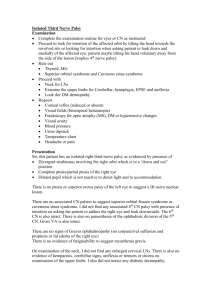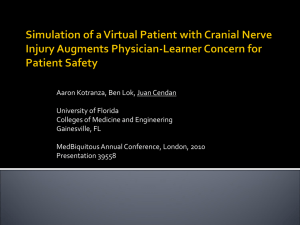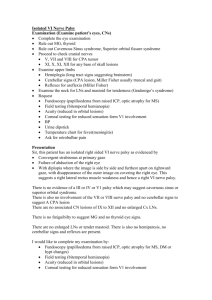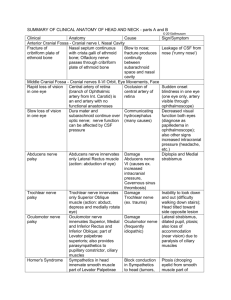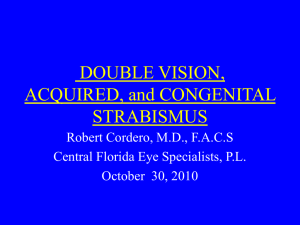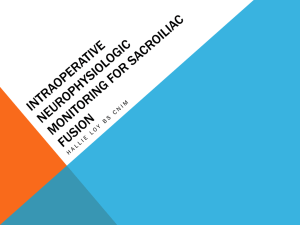3rd Nerve Palsy - University of Louisville Department of
advertisement
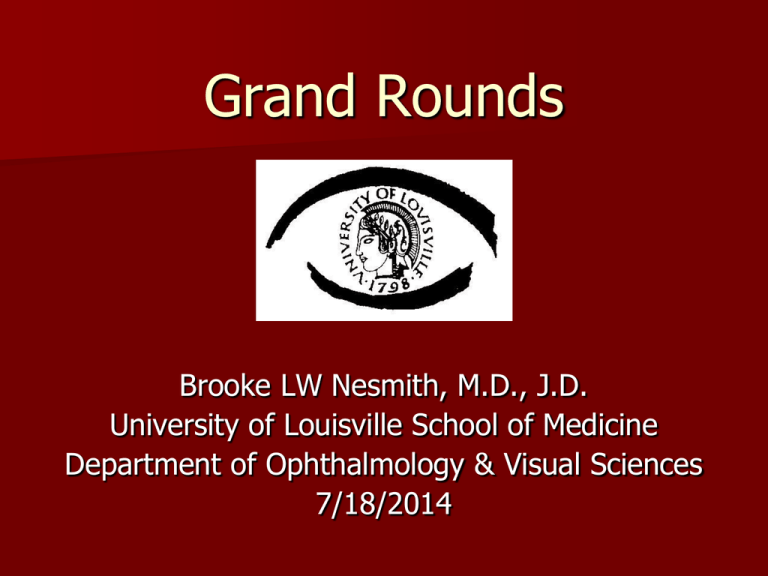
Grand Rounds Brooke LW Nesmith, M.D., J.D. University of Louisville School of Medicine Department of Ophthalmology & Visual Sciences 7/18/2014 Presentation CC: Diplopia x 5 days. HPI: 60 year old male presents with onset of binocular diplopia 5 days ago, with subsequent left lid ptosis 2 days later. No other visual acuity changes. History POH: Proliferative diabetic retinopathy OU s/p panretinal photocoagulation PMH: Type II diabetes, hypertension, hyperlipidemia, coronary artery disease Allergies: NKDA Exam 20/25 VAsc 20/400 14 3 2mm P (-) RAPD 3 2mm T 14 Exam Findings Ext/L/L Conj K AC Iris/Lens DFE OD OS wnl wnl wnl wnl PCIOL wnl wnl wnl wnl PCIOL -panretinal photocoagulation- Exam Exam Assessment 60 year old male presents with left pupil-sparing 3rd nerve palsy. MRI/MRA negative. Observe. Follow-up 3rd nerve palsy resolved at two month follow-up. 3rd Nerve Palsy Anatomy Causes 3rd Nerve Pathway 3rd Nerve Pathway 3rd Nerve Pathway 3rd Nerve Pathway 3rd Nerve Palsy Nuclear Fascicle syndromes (brainstem) Uncal herniation Cavernous Sinus Isolated – – – – Pupil-involving Pupil-sparing Divisional Younger patients Nuclear 3rd Nerve Palsy uncommon Fascicle Syndromes Weber syndrome – contralateral hemiparesis (cerebral peduncle) Benedikt syndrome - contralateral ataxia or tremor (red nucleus & Claude syndrome – contralateral ataxia (superior cerebellar substantia nigra) peduncle) Uncal Herniation Uncal herniation Cavernous Sinus Syndrome Cavernous Sinus – other cranial nerves Pupil Involving 3rd Nerve Palsy Aneurysm at junction of posterior communicating artery and internal carotid artery Partial pupil involvement in 25-47% of patients with posterior communicating artery aneurysms Pupil Sparing 3rd Nerve Palsy Microvascular ischemia – most common cause – pupillary involvement in up to 20% (typically mild ≤ 1mm anisocoria) – may present with pain – diplopia improves within 3 months Aberrant regeneration – common after trauma or compression by aneurysm or tumor – NOT WITH MICROVASCULAR ISCHEMIA Case Report Grunwald L, Sund NJ, Volpe NJ. Pupillary sparing and aberrant regeneration in chronic third nerve palsy secondary to a posterior communicating aneurysm. BR J Ophthalmol 2008;92:715-716. 3rd Nerve Palsy Rare causes tumor, inflammation (sarcoid), vasculitis, infection (meningitis), infiltration (lymphoma, carcinoma), trauma (pupil involving) Divisional – lesion of anterior cavernous sinus or possibly posterior orbit Children – ophthalmoplegic migraine – ophthalmoplegia develops days after onset of head pain References Zarbin M, Chu D. The evaluation of isolated third nerve palsy revisited: An update on the evolving role of magnetic resonance, computed tomography, and catheter angiography. Surv Ophthalmol 2002 47:137-157. BCSC 2013-2014 Section 5 NeuroOphthalmology. Pages 209-218. Jacobson DM. Relative pupil-sparing third nerve palsy: etiology and clinical variables predictive of a mass. Neurology 2001 27;56(6):797-8. Sobreira I, Sousa C, Raposo A, Fagundes F, Dias A. Ophthalmoplegic migraine with persistent dilated pupil. J Child Neurol 2013 28:275. Thank you.

